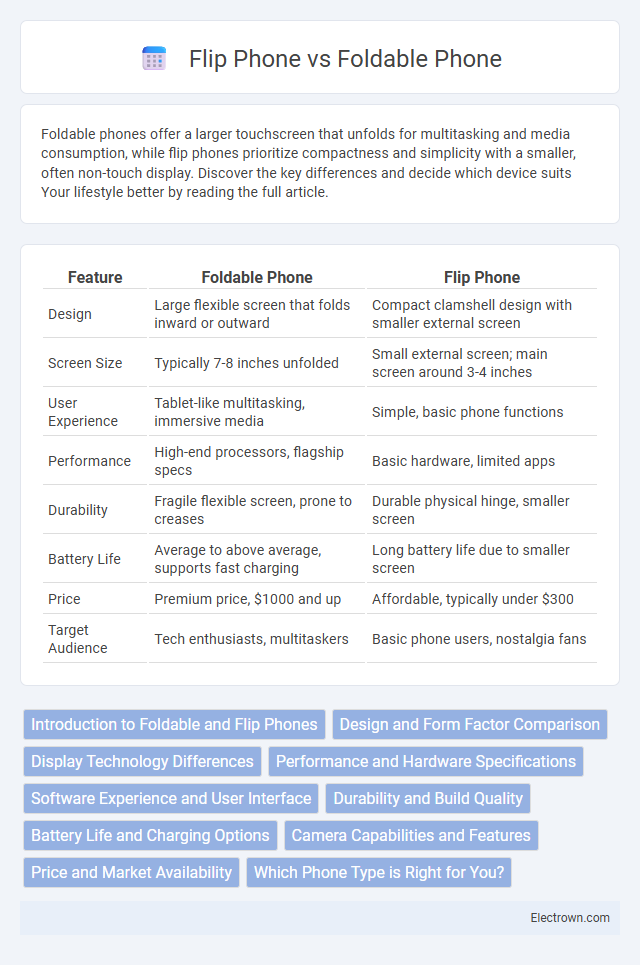Foldable phones offer a larger touchscreen that unfolds for multitasking and media consumption, while flip phones prioritize compactness and simplicity with a smaller, often non-touch display. Discover the key differences and decide which device suits Your lifestyle better by reading the full article.
Table of Comparison
| Feature | Foldable Phone | Flip Phone |
|---|---|---|
| Design | Large flexible screen that folds inward or outward | Compact clamshell design with smaller external screen |
| Screen Size | Typically 7-8 inches unfolded | Small external screen; main screen around 3-4 inches |
| User Experience | Tablet-like multitasking, immersive media | Simple, basic phone functions |
| Performance | High-end processors, flagship specs | Basic hardware, limited apps |
| Durability | Fragile flexible screen, prone to creases | Durable physical hinge, smaller screen |
| Battery Life | Average to above average, supports fast charging | Long battery life due to smaller screen |
| Price | Premium price, $1000 and up | Affordable, typically under $300 |
| Target Audience | Tech enthusiasts, multitaskers | Basic phone users, nostalgia fans |
Introduction to Foldable and Flip Phones
Foldable phones feature flexible OLED displays that fold inward or outward, allowing a larger screen to fit into a compact form factor, enhancing multitasking and media consumption. Flip phones, often known for their clamshell design, use a traditional hinge mechanism to fold a rigid screen and keypad, prioritizing portability and nostalgia. Both technologies offer unique user experiences by balancing screen size and device compactness with distinct hardware designs.
Design and Form Factor Comparison
Foldable phones feature a flexible OLED display that unfolds into a larger, tablet-sized screen, offering expanded viewing and multitasking capabilities. Flip phones have a clamshell design with two rigid halves connected by a hinge, providing a compact form when closed and a standard smartphone interface when open. The foldable phone's seamless display emphasizes screen continuity, while the flip phone focuses on portability and protection of the smaller screen.
Display Technology Differences
Foldable phones utilize flexible OLED panels that allow the entire display to bend seamlessly, offering a larger continuous screen when unfolded. Flip phones typically employ traditional rigid screens divided by a hinge, limiting display size and usability when opened. The advancements in foldable display technology enable improved multitasking and immersive viewing experiences compared to the segmented displays found in flip phones.
Performance and Hardware Specifications
Foldable phones typically feature advanced hardware with larger, flexible OLED screens, high-refresh-rate displays, and flagship-grade processors such as the Snapdragon 8 Gen series, delivering superior performance for multitasking and gaming. Flip phones, often designed for simplicity, come with compact, fixed screens and mid-range processors, prioritizing battery efficiency and portability over raw power. Foldable phones also include more RAM, enhanced camera systems, and versatile connectivity options, making them powerful devices compared to traditional flip phones that focus on basic communication functions.
Software Experience and User Interface
Foldable phones offer advanced software experiences optimized for larger, flexible displays, enabling seamless multitasking with split-screen functionality and adaptive user interfaces that adjust to screen folding states. Flip phones, typically featuring smaller, non-flexible displays, rely on simplified user interfaces designed for quick access and compatibility with traditional single-screen applications. Foldable devices provide a more immersive and dynamic user experience by supporting app continuity and enhanced gesture controls, while flip phones prioritize straightforward usability and compact form factors.
Durability and Build Quality
Foldable phones feature advanced flexible OLED displays with reinforced layers, yet their hinge mechanisms remain susceptible to wear and dust ingress, impacting long-term durability. Flip phones, often fabricated with robust materials and simpler folding designs, typically offer superior build quality and resilience under repeated use. Consumer reports highlight that flip phones generally withstand drops and hinges stress better than foldable models, which require more careful handling.
Battery Life and Charging Options
Foldable phones typically feature larger batteries ranging from 4,000 to 5,000 mAh, supporting fast charging, wireless charging, and sometimes reverse wireless charging, enhancing overall battery endurance and convenience. Flip phones usually have smaller batteries around 1,500 to 2,500 mAh, with limited fast charging capabilities and often lack wireless charging support, resulting in shorter battery life. Battery performance varies due to screen size and usage patterns, making foldable phones more suitable for extended daily use.
Camera Capabilities and Features
Foldable phones typically offer advanced camera capabilities with multiple lenses, higher megapixel counts, and enhanced features like optical zoom and night mode, providing versatile photography options. Flip phones usually have simpler cameras focused on basic photo and video functions, often with lower resolution and fewer enhancements. Your choice depends on whether you prioritize sophisticated camera performance or compact design with basic imaging features.
Price and Market Availability
Foldable phones typically command higher prices, ranging from $1,000 to $2,000, due to advanced flexible display technology and cutting-edge hardware, while flip phones often cost between $50 and $300, targeting budget-conscious consumers. Market availability of foldable phones remains limited, primarily offered by premium brands like Samsung, Huawei, and Motorola, with select models in major global markets. Flip phones maintain broader availability across diverse regions and carriers, benefiting from established manufacturing and strong demand in emerging markets.
Which Phone Type is Right for You?
Foldable phones offer larger, tablet-like screens that enhance multitasking, gaming, and media consumption, making them ideal for productivity and immersive experiences. Flip phones provide compactness and nostalgic charm with simpler functionality, better fitting users who prioritize portability and basic communication. Your choice depends on whether you value advanced screen versatility or streamlined convenience in daily phone use.
Foldable Phone vs Flip Phone Infographic

 electrown.com
electrown.com